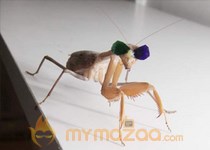When the insects are shown simulations of their favourite food on a screen they only try to catch it if the video is shown in 3D.
By Gerard Tubb, Sky News Correspondent
Insects fitted with tiny 3D glasses are showing scientists how they can catch fast-moving camouflaged crickets despite having brains no bigger than a pin head.
Blobs of harmless beeswax are being used to fix green and blue lenses to praying mantises in experiments at Newcastle University.
When the insects are shown simulations of their favourite food on a screen they only try to catch it if the video is shown in 3D.
Professor Jenny Read told Sky News her team's research is a breakthrough that could lead to new ways of using three-dimensional vision in computers and robots.
She explained: "An insect's tiny brain, just a few millimetres across, is very useful to scientists because it is so stripped-down and simple," she explained.
"Our mantis 3D glasses will be a great tool for studying 3D vision in insects - now we can make the experiments more complicated and build algorithms based on our research."
Professor Read said the study, funded by the Leverhulme Trust, could also shed light on the role of 3D vision in evolution.
And it seems the mantises don't mind wearing the glasses for a few weeks before they fall of naturally.
"It's difficult to tell if a praying mantis is happy, but they catch crickets just the same in their cages whether they're wearing the glasses or not," she said.







